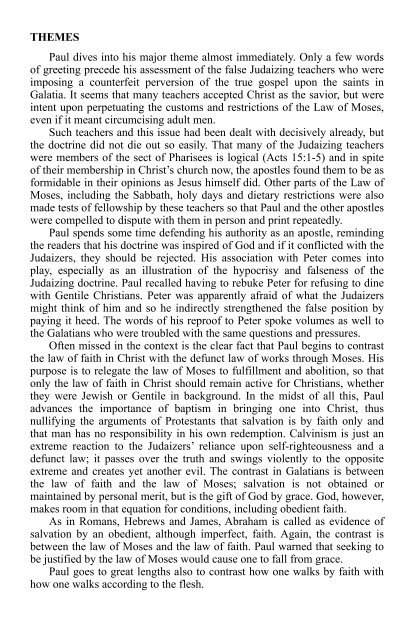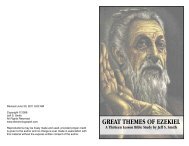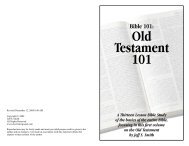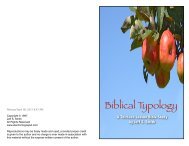New Testament Study Guides - ElectronicGospel
New Testament Study Guides - ElectronicGospel
New Testament Study Guides - ElectronicGospel
You also want an ePaper? Increase the reach of your titles
YUMPU automatically turns print PDFs into web optimized ePapers that Google loves.
THEMES<br />
Paul dives into his major theme almost immediately. Only a few words<br />
of greeting precede his assessment of the false Judaizing teachers who were<br />
imposing a counterfeit perversion of the true gospel upon the saints in<br />
Galatia. It seems that many teachers accepted Christ as the savior, but were<br />
intent upon perpetuating the customs and restrictions of the Law of Moses,<br />
even if it meant circumcising adult men.<br />
Such teachers and this issue had been dealt with decisively already, but<br />
the doctrine did not die out so easily. That many of the Judaizing teachers<br />
were members of the sect of Pharisees is logical (Acts 15:1-5) and in spite<br />
of their membership in Christ’s church now, the apostles found them to be as<br />
formidable in their opinions as Jesus himself did. Other parts of the Law of<br />
Moses, including the Sabbath, holy days and dietary restrictions were also<br />
made tests of fellowship by these teachers so that Paul and the other apostles<br />
were compelled to dispute with them in person and print repeatedly.<br />
Paul spends some time defending his authority as an apostle, reminding<br />
the readers that his doctrine was inspired of God and if it conflicted with the<br />
Judaizers, they should be rejected. His association with Peter comes into<br />
play, especially as an illustration of the hypocrisy and falseness of the<br />
Judaizing doctrine. Paul recalled having to rebuke Peter for refusing to dine<br />
with Gentile Christians. Peter was apparently afraid of what the Judaizers<br />
might think of him and so he indirectly strengthened the false position by<br />
paying it heed. The words of his reproof to Peter spoke volumes as well to<br />
the Galatians who were troubled with the same questions and pressures.<br />
Often missed in the context is the clear fact that Paul begins to contrast<br />
the law of faith in Christ with the defunct law of works through Moses. His<br />
purpose is to relegate the law of Moses to fulfillment and abolition, so that<br />
only the law of faith in Christ should remain active for Christians, whether<br />
they were Jewish or Gentile in background. In the midst of all this, Paul<br />
advances the importance of baptism in bringing one into Christ, thus<br />
nullifying the arguments of Protestants that salvation is by faith only and<br />
that man has no responsibility in his own redemption. Calvinism is just an<br />
extreme reaction to the Judaizers’ reliance upon self-righteousness and a<br />
defunct law; it passes over the truth and swings violently to the opposite<br />
extreme and creates yet another evil. The contrast in Galatians is between<br />
the law of faith and the law of Moses; salvation is not obtained or<br />
maintained by personal merit, but is the gift of God by grace. God, however,<br />
makes room in that equation for conditions, including obedient faith.<br />
As in Romans, Hebrews and James, Abraham is called as evidence of<br />
salvation by an obedient, although imperfect, faith. Again, the contrast is<br />
between the law of Moses and the law of faith. Paul warned that seeking to<br />
be justified by the law of Moses would cause one to fall from grace.<br />
Paul goes to great lengths also to contrast how one walks by faith with<br />
how one walks according to the flesh.









